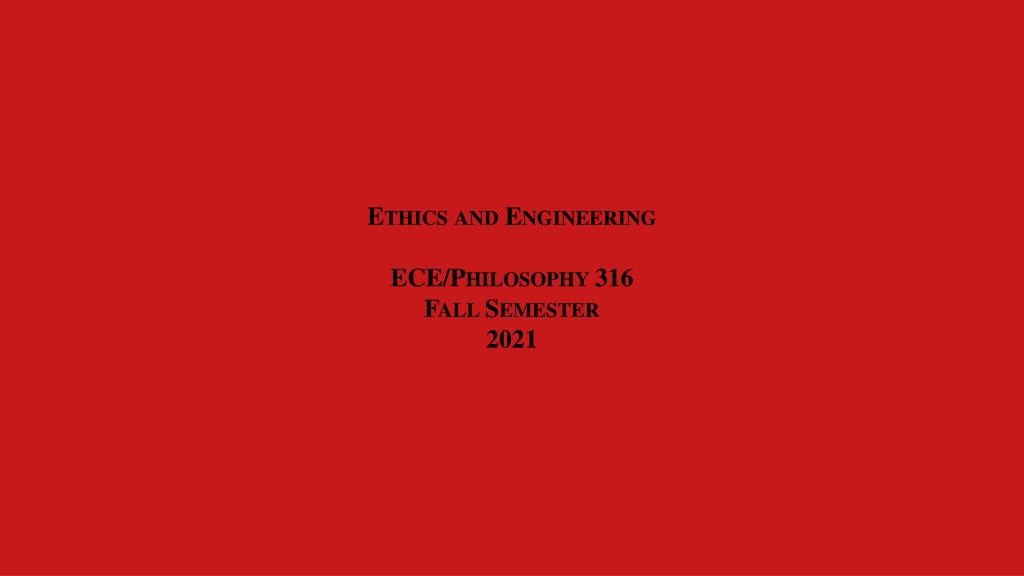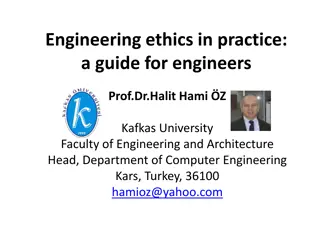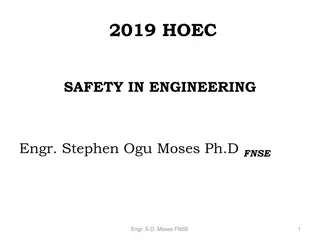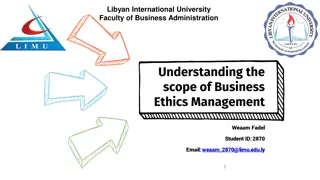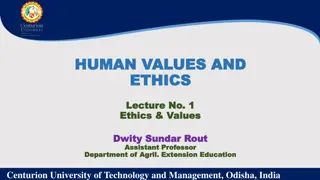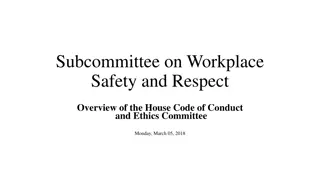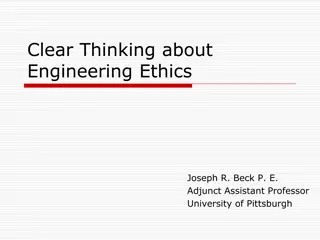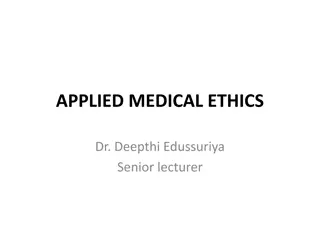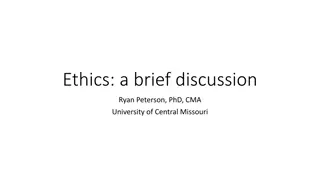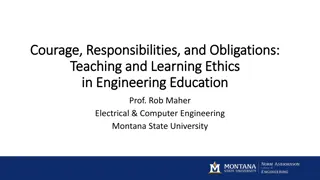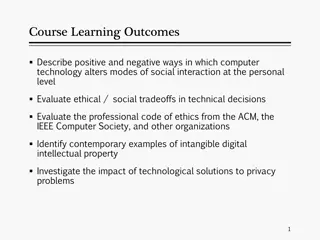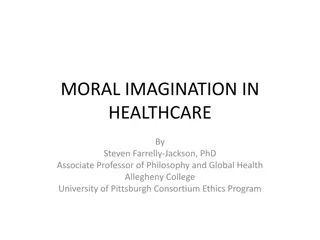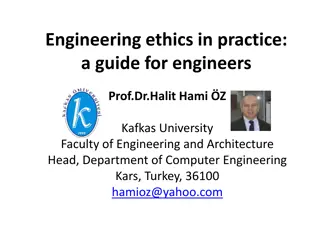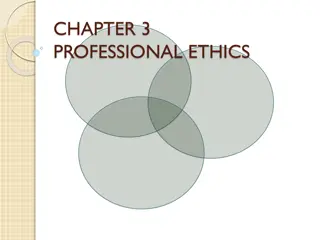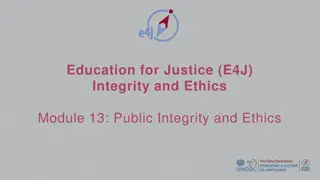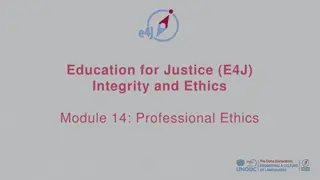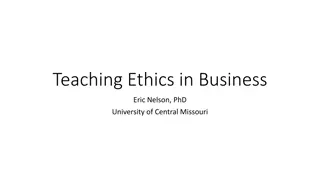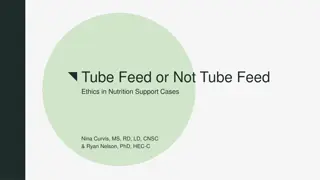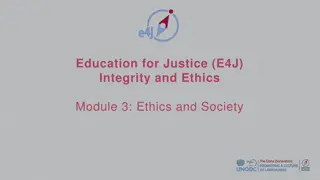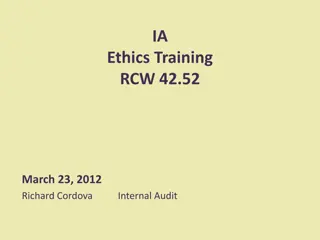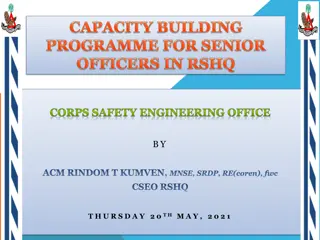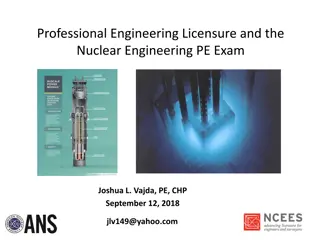Exploring the Importance of Safety in Engineering Ethics
Delve into the significance of safety in engineering ethics through reflections, case studies, and readings. Uncover the essence of safety, its quality, and why it stands crucial to human well-being and ethical engineering practices.
Download Presentation

Please find below an Image/Link to download the presentation.
The content on the website is provided AS IS for your information and personal use only. It may not be sold, licensed, or shared on other websites without obtaining consent from the author. Download presentation by click this link. If you encounter any issues during the download, it is possible that the publisher has removed the file from their server.
E N D
Presentation Transcript
ETHICSAND ENGINEERING ECE/PHILOSOPHY 316 FALL SEMESTER 2021
Readings [1] Engineering Ethics: Concepts and Cases, Chapter 6, "The Engineer s Responsibility to Assess and Manage Risk," 121 54 Case 2: Big Dig Collapse, 211 12
Readings [2] The Hyatt Regency Hotel Walkway Collapse, 1981 Petroski, To Engineer Is Human, "Preface," xi xii, Chapter 1: "Being Human," 1 5, 9 10, Chapter 8: "Accidents Waiting to Happen," 85 97 The Philadelphia Inquirer, June 14 and June 7, 1979 Martin and Schinzinger, Ethics in Engineering, 16 20 The Hyatt Decision: Two Opinions, 69 72
Readings [3] The Boston Central Artery/Tunnel Project, 1991 2006 Fein, Boston s Big Dig and Figures 1, 2, and 3 Sullivan, Reply to The Boston Globe s Investigative News Series Concerning the Big Dig, Letter from the Office of the Inspector General to the Massachusetts Turnpike Authority
Safety. What is it? We all need it. Safety is at the heart of human well-being. The lexical definition of safety is the quality or condition of being safe [from the Latin word salvus ; related to salus, meaning health or sound condition ], and to be safe is to be free from damage, danger, or injury, or to be secure. 1 1Webster s New World Dictionary (New York: World Pub. Co., 1953), 1283.
The definition of safety points us to the meaning of the word, but why is safety so important to us?
The definition of safety points us to the meaning of the word, but why is safety so important to us? Everything in this world needs safety for its survival, but human beings are immediately aware of this need.
The definition of safety points us to the meaning of the word, but why is safety so important to us? Everything in this world needs safety for its survival, but human beings are immediately aware of this need. The human psyche has a profound need for safety and every fear and every anxiety of the human psyche is itself rooted in a fundamental awareness (even at an unconscious level) of the essential need for safety.
The engineer is a human being, living in a society of human beings, with a responsibility as an engineer to provide safety in society at many levels.
The engineer is a human being, living in a society of human beings, with a responsibility as an engineer to provide safety in society at many levels. In light of this professional responsibility, engage and read critically the readings from chapter six of Engineering Ethics: Concepts and Cases on The Engineer s Responsibility to Assess and Manage Risk.
Why the Towers Fell 2001
What is risk, and how is risk related to safety? The Oxford English Dictionary suggests a working definition of safety in relation to engineering as the ratio between the strains [that can safely be] put upon any material and the ultimate strength of the material. 2 2The Oxford Universal Dictionary on Historical Principles, prepared by William Little, A.W. Fowler, and J. Coulson; revised and edited by C.T. Onions, 3rd edition (Oxford: Oxford University Press, 1955), 1778. See also The Compact Edition of the Oxford English Dictionary: Complete Text Reproduced Micrographically (Oxford: Oxford University Press, 1971), 2620 [ S, 29], citing the work of Humber, who was an engineer writing in the year 1868.
Yet the concept of risk encompasses not simply materials, but the entire scope of engineering practice. The engineer has a responsibility to understand the potential risk involved (of injury, damage, or loss) in any given project or new form of technology, and a corresponding responsibility to design in a way that minimizes risk.
An Engineering Definition of Risk To assess a risk of harm, an engineer must identify it and quantify it. Engineers often define risk at the product of the probability (pi) of harm and the magnitude (hi) of that harm... ? ???? = ?? ? ?=1
An Engineering Definition of Risk To assess a risk of harm, an engineer must identify it and quantify it. Engineers often define risk at the product of the probability (pi) of harm and the magnitude (hi) of that harm... ? ???? = ?? ? ?=1 The index itracks through a list of all the potential harmful effects: 1, , n
An Engineering Definition of Risk To assess a risk of harm, an engineer must identify it and quantify it. Engineers often define risk at the product of the probability (pi) of harm and the magnitude (hi) of that harm... ? ???? = ?? ? ?=1 The index itracks through a list of all the potential harmful effects: 1, , n Risk in the equation above is the total sum of all individual sources of potential harm: Risk = p1h1 + p2h2 + ... + pnhn (? is shorthand notation for a sum)
An Engineering Definition of Risk To assess a risk of harm, an engineer must identify it and quantify it. Engineers often define risk at the product of the probability (pi) of harm and the magnitude (hi) of that harm... ? ???? = ?? ? ?=1 The index itracks through a list of all the potential harmful effects: 1, , n Risk in the equation above is the total sum of all individual sources of potential harm: Risk = p1h1 + p2h2 + ... + pnhn (? is shorthand notation for a sum) Multiplication of harm and magnitude (pihi): weight the likelihood of a potential harm by its impact
Reflect on the two characteristics of modern technology that Charles Perrow refers to (in the sixth chapter of Engineering Ethics: Concepts and Cases) as tight coupling and complex interactions. 3 How do these factors complicate the prediction of risk? 3 Charles E. Harris, Jr., et al., Engineering Ethics: Concepts and Cases, 6th edition (Boston: Cengage, 2019), 134.
Diagram adapted from Perrow, Normal Accidents: Living with High-Risk Technologies, 97
Tight Coupling Diagram adapted from Perrow, Normal Accidents: Living with High-Risk Technologies, 97
Complex Interactions Tight Coupling Diagram adapted from Perrow, Normal Accidents: Living with High-Risk Technologies, 97
Complex Interactions Tight Coupling Diagram adapted from Perrow, Normal Accidents: Living with High-Risk Technologies, 97
Complex Interactions Tight Coupling Diagram adapted from Perrow, Normal Accidents: Living with High-Risk Technologies, 97
Complex Interactions Tight Coupling Manufacturing Trade Schools Diagram adapted from Perrow, Normal Accidents: Living with High-Risk Technologies, 97
Complex Interactions Dams Railroads Tight Coupling Manufacturing Trade Schools Diagram adapted from Perrow, Normal Accidents: Living with High-Risk Technologies, 97
Complex Interactions Dams Railroads Tight Coupling Manufacturing Mining Trade Schools Universities Diagram adapted from Perrow, Normal Accidents: Living with High-Risk Technologies, 97
Complex Interactions Nuclear Power Dams Space Exploration Railroads Tight Coupling Manufacturing Mining Trade Schools Universities Diagram adapted from Perrow, Normal Accidents: Living with High-Risk Technologies, 97
Reflect on the Hyatt Regency Walkway collapse in 1981. The Hyatt atrium was six stories high, with walkways designed architecturally to appear as hanging in the air.
Reflect on the Hyatt Regency Walkway collapse in 1981. The Hyatt atrium was six stories high, with walkways designed architecturally to appear as hanging in the air. The design was difficult to build, and so a request was made to change the design.
Reflect on the Hyatt Regency Walkway collapse in 1981. The Hyatt atrium was six stories high, with walkways designed architecturally to appear as hanging in the air. The design was difficult to build, and so a request was made to change the design. The change in construction was approved, but the necessary weight-bearing calculations needed for this change (to ensure the proper support of the walkways) were never done.
The Hyatt disaster was the most devastating structural failure in American history (prior to the Twin Towers in 2001).
A metal distribution plate (at the cost of $1) would have prevented this tragedy.
Study the diagram in Martin and Schinzinger, Ethics in Engineering, and the Facts and Findings of Judge Deutsch mentioned in the article published in Civil Engineering, The Hyatt Decision: Two Opinions. 4 4 Mike W. Martin and Roland Schinzinger, Ethics in Engineering, 4th edition (Boston: McGraw-Hill, 2005), 19; and Civil Engineering 56, no. 9 (September 1986): 69 71.
The Boston Central Artery/Tunnel Project 1991-2006
The Boston underground project, known as the Big Dig, was the largest and most complex urban infrastructure project ever undertaken in the modern world. 5 5 Dan McNichol, The Big Dig (New York: Silver Lining Books, 2002), 10.
It is an amazing story, but with many cost overruns and a fatal flaw that occurred the year it opened in 2006.6 6See Case 2: Big Dig Collapse in Harris, et al., Engineering Ethics, 211 12.
Breakout Rooms Reflect on the Engineer s Responsibility for Safety
Breakout Rooms Reflect on the Engineer s Responsibility for Safety through the lens of the Hyatt Walkway Collapse and the Boston Central Artery/Tunnel Project
Breakout Rooms Reflect on the Engineer s Responsibility for Safety through the lens of the Hyatt Walkway Collapse and the Boston Central Artery/Tunnel Project What are the main insights and lessons that can be learned?
